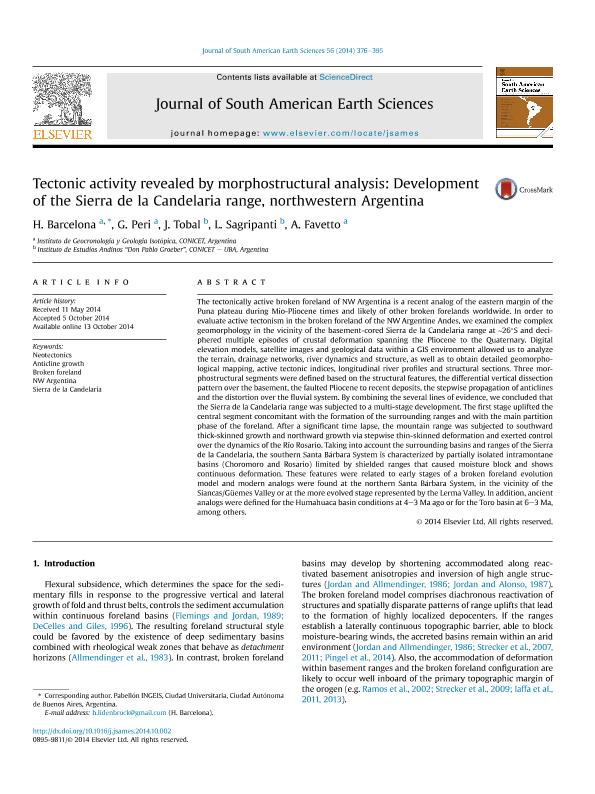Artículo
Tectonic activity revealed by morphostructural analysis: Development of the Sierra de la Candelaria range, northwestern Argentina
Barcelona, Hernan ; Peri, Verónica Gisel
; Peri, Verónica Gisel ; Tobal, Jonathan Elías
; Tobal, Jonathan Elías ; Sagripanti, Lucía
; Sagripanti, Lucía ; Favetto, Alicia Beatriz
; Favetto, Alicia Beatriz
 ; Peri, Verónica Gisel
; Peri, Verónica Gisel ; Tobal, Jonathan Elías
; Tobal, Jonathan Elías ; Sagripanti, Lucía
; Sagripanti, Lucía ; Favetto, Alicia Beatriz
; Favetto, Alicia Beatriz
Fecha de publicación:
10/2014
Editorial:
Elsevier
Revista:
Journal of South American Earth Sciences
ISSN:
0895-9811
Idioma:
Inglés
Tipo de recurso:
Artículo publicado
Clasificación temática:
Resumen
The tectonically active broken foreland of NW Argentina is a recent analog of the eastern margin of the Puna plateau during Mio-Pliocene times and likely of other broken forelands worldwide. In order to evaluate active tectonism in the broken foreland of the NW Argentine Andes, we examined the complex geomorphology in the vicinity of the basement-cored Sierra de la Candelaria range at ∼26°S and deciphered multiple episodes of crustal deformation spanning the Pliocene to the Quaternary. Digital elevation models, satellite images and geological data within a GIS environment allowed us to analyze the terrain, drainage networks, river dynamics and structure, as well as to obtain detailed geomorphological mapping, active tectonic indices, longitudinal river profiles and structural sections. Three morphostructural segments were defined based on the structural features, the differential vertical dissection pattern over the basement, the faulted Pliocene to recent deposits, the stepwise propagation of anticlines and the distortion over the fluvial system. By combining the several lines of evidence, we concluded that the Sierra de la Candelaria range was subjected to a multi-stage development. The first stage uplifted the central segment concomitant with the formation of the surrounding ranges and with the main partition phase of the foreland. After a significant time lapse, the mountain range was subjected to southward thick-skinned growth and northward growth via stepwise thin-skinned deformation and exerted control over the dynamics of the Río Rosario. Taking into account the surrounding basins and ranges of the Sierra de la Candelaria, the southern Santa Bárbara System is characterized by partially isolated intramontane basins (Choromoro and Rosario) limited by shielded ranges that caused moisture block and shows continuous deformation. These features were related to early stages of a broken foreland evolution model and modern analogs were found at the northern Santa Bárbara System, in the vicinity of the Siancas/Güemes Valley or at the more evolved stage represented by the Lerma Valley. In addition, ancient analogs were defined for the Humahuaca basin conditions at 4–3 Ma ago or for the Toro basin at 6–3 Ma, among others.
Palabras clave:
Neotectonics
,
Anticline Growth
,
Broken Foreland
,
Sierra de La Candelaria
Archivos asociados
Licencia
Identificadores
Colecciones
Articulos(IDEAN)
Articulos de INSTITUTO DE ESTUDIOS ANDINOS "DON PABLO GROEBER"
Articulos de INSTITUTO DE ESTUDIOS ANDINOS "DON PABLO GROEBER"
Articulos(INGEIS)
Articulos de INST.DE GEOCRONOLOGIA Y GEOLOGIA ISOTOPICA (I)
Articulos de INST.DE GEOCRONOLOGIA Y GEOLOGIA ISOTOPICA (I)
Citación
Barcelona, Hernan; Sagripanti, Lucía; Tobal, Jonathan Elías; Peri, Verónica Gisel; Favetto, Alicia Beatriz; Tectonic activity revealed by morphostructural analysis: Development of the Sierra de la Candelaria range, northwestern Argentina; Elsevier; Journal of South American Earth Sciences; 56; 10-2014; 376-395
Compartir
Altmétricas



